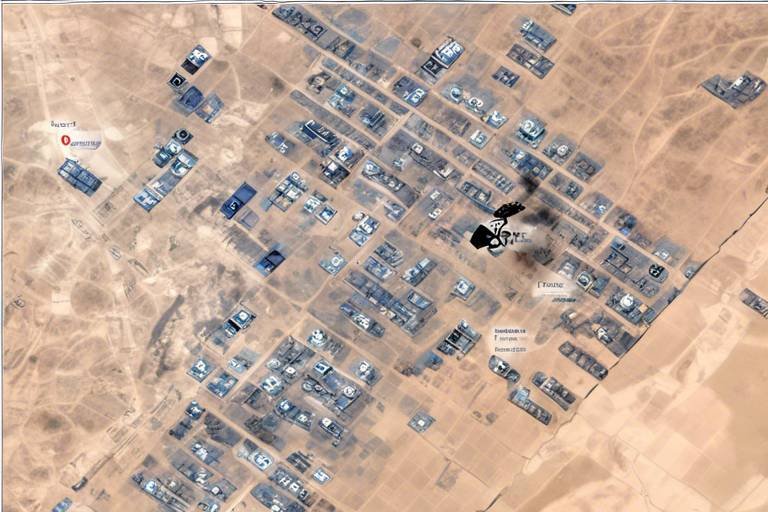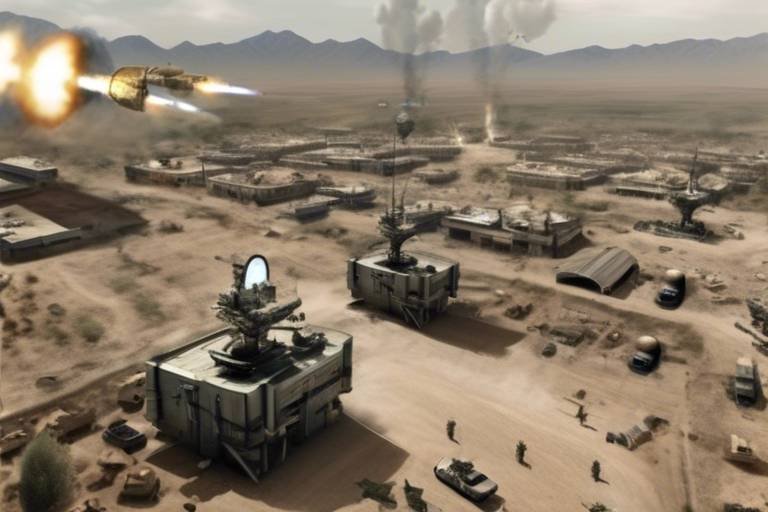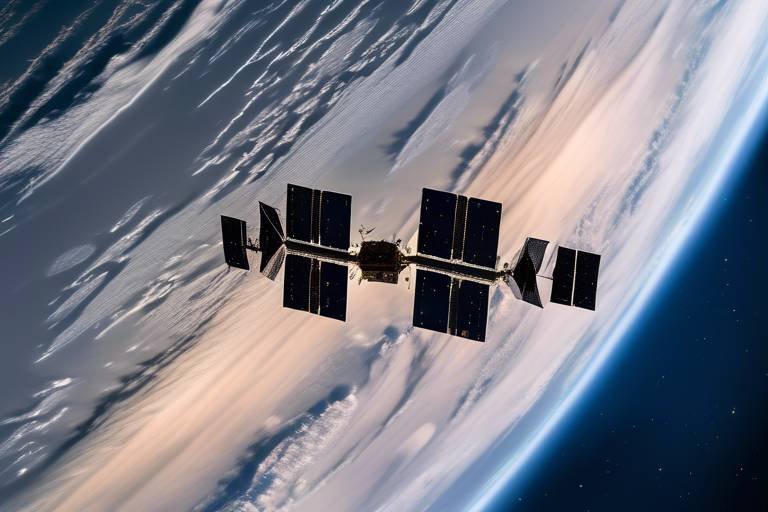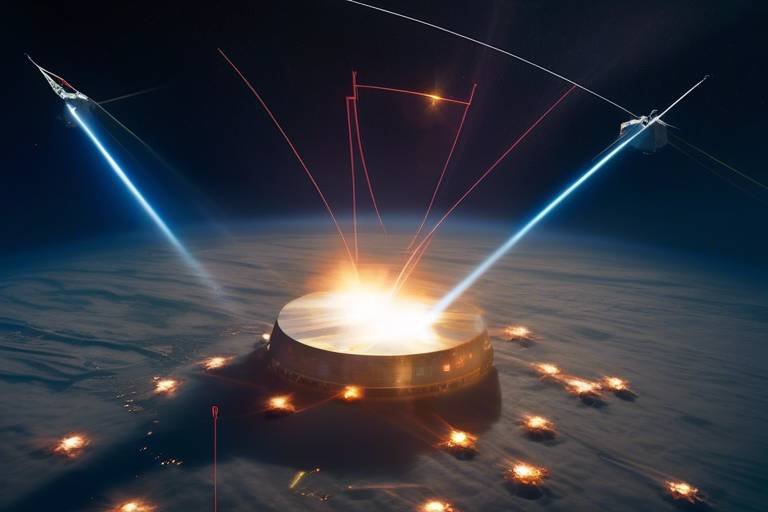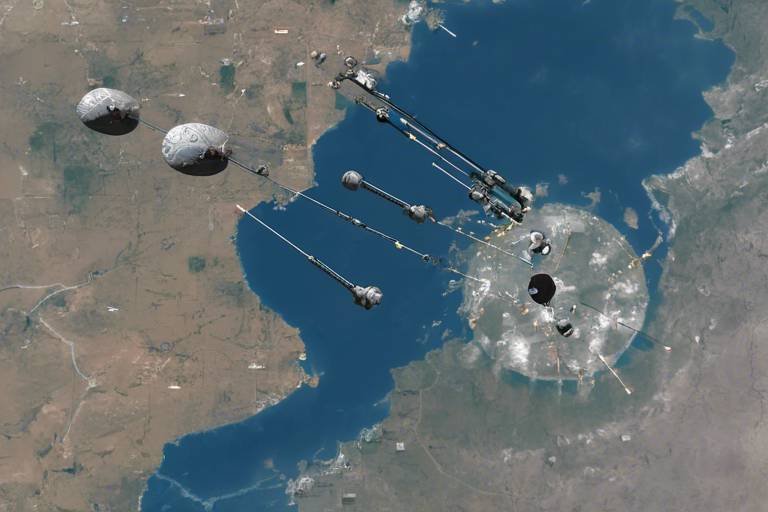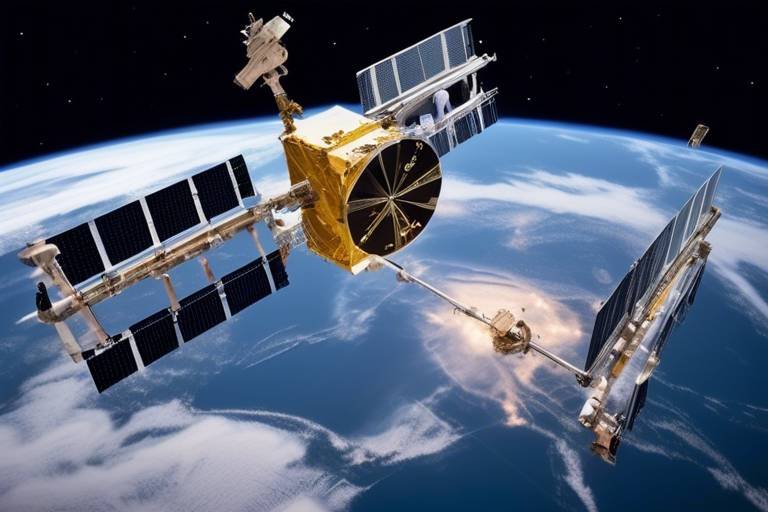Understanding the Use of Satellites in Joint Operations
In today's fast-paced and ever-evolving military landscape, the importance of satellites in joint operations cannot be overstated. These technological marvels serve as the backbone of modern warfare, enabling seamless communication, precise navigation, and comprehensive surveillance. Imagine a symphony where each instrument plays in perfect harmony; that's how satellites facilitate collaboration among allied forces across the globe. Without them, the coordination required for effective joint operations would be nearly impossible, leading to inefficiencies and potential mission failures.
Satellites act as a bridge, connecting various military units and ensuring that vital information flows freely and swiftly. This real-time data sharing is crucial, especially in high-stakes situations where every second counts. For instance, during a joint operation involving multiple nations, a delay in communication could result in catastrophic consequences. Thus, the role of satellites in enhancing mission effectiveness and reducing response times is not just significant; it's absolutely critical.
Moreover, these satellites are equipped with advanced technology that allows for sophisticated data collection and analysis. They provide a bird's-eye view of the battlefield, enabling commanders to make informed decisions based on real-time intelligence. This capability transforms the way military strategies are developed and executed, allowing forces to adapt quickly to changing circumstances. It's like having a tactical advantage that can turn the tide of a battle in an instant.
In addition to communication and surveillance, satellites also play a pivotal role in navigation. The Global Navigation Satellite Systems (GNSS) are essential for accurate positioning, which is vital for synchronizing movements among different military units. Picture a complex chess game where each piece must move in perfect alignment with the others; that's how GNSS ensures that forces can operate together effectively. This level of coordination not only increases operational efficiency but also significantly enhances the safety of troops on the ground.
However, as we delve deeper into the world of satellites in joint operations, it's essential to acknowledge the challenges that come with this reliance on technology. While satellites offer unparalleled advantages, they also present vulnerabilities, such as susceptibility to jamming and spoofing. Therefore, military forces must implement robust countermeasures to mitigate these risks and ensure mission success. It's a delicate balance between leveraging technology and safeguarding against its potential pitfalls.
In conclusion, the use of satellites in joint military operations is a game-changer. They enhance communication, navigation, and surveillance capabilities, allowing allied forces to work together more effectively than ever before. As we continue to witness advancements in satellite technology, the future of joint operations looks promising, albeit with its own set of challenges that must be addressed. It's clear that the sky is not the limit; it's just the beginning of a new era in military operations.
- What are the primary functions of satellites in military operations?
Satellites primarily enhance communication, navigation, and surveillance capabilities among military units, facilitating real-time data sharing and operational coordination.
- How does GPS technology contribute to joint operations?
GPS technology provides accurate location data that enables forces to execute missions with precision, thereby minimizing the risk of friendly fire.
- What are the risks associated with reliance on satellite technology?
While satellites offer significant advantages, they are vulnerable to jamming and spoofing, necessitating the implementation of countermeasures to ensure mission success.
- How do satellites improve situational awareness?
Satellites provide comprehensive surveillance and reconnaissance capabilities, offering commanders valuable insights into enemy positions and movements, which informs strategic decision-making.
The Role of Satellites in Military Communication
In the ever-evolving landscape of modern warfare, the role of satellites in military communication cannot be overstated. These technological marvels serve as the backbone of communication, enabling military units to maintain a seamless flow of information across vast distances. Imagine a battlefield where troops are scattered across different terrains, each unit operating under unique circumstances. Without the ability to communicate effectively, coordination would be nearly impossible, and the risk of operational failure would skyrocket. This is where satellites come into play, acting as the vital link that connects various forces, ensuring that every unit operates in harmony.
One of the most significant advantages of satellite communication is its ability to provide real-time data sharing. This means that, during joint operations, military personnel can exchange critical information instantaneously, allowing for rapid decision-making. For instance, if a reconnaissance unit identifies an enemy position, they can relay this information to command centers and other units within seconds. This capability significantly enhances mission effectiveness and reduces response times, which is crucial in high-stakes scenarios where every second counts.
Moreover, satellites facilitate communication in environments where traditional methods may fail. Whether it's dense urban areas, remote wilderness, or even hostile territories, satellite communication remains reliable. This resilience is vital for ensuring that all units, regardless of their location, can stay connected. In fact, many military operations rely on satellite networks to establish communication links that are not only robust but also secure, protecting sensitive information from potential adversaries.
To illustrate the importance of satellite communication, consider the following key features:
- Global Reach: Satellites provide coverage over vast geographical areas, ensuring that troops can communicate regardless of their location.
- Real-Time Updates: Instantaneous data sharing allows for quick adjustments to strategies and tactics based on the latest intelligence.
- Secure Channels: Advanced encryption technologies help safeguard communications from interception.
In conclusion, satellites play a critical role in military communication, transforming how allied forces coordinate and execute joint operations. Their ability to provide reliable, real-time communication across diverse environments not only enhances operational effectiveness but also safeguards the integrity of sensitive military information. As technology continues to advance, the importance of satellites in military communication will only grow, making them indispensable in the quest for strategic advantage on the battlefield.
Satellite Navigation Systems
Global Navigation Satellite Systems (GNSS) have become the backbone of modern military operations, transforming the way forces navigate and coordinate their movements on the battlefield. These systems utilize a constellation of satellites orbiting the Earth to provide accurate positioning data, allowing military units to synchronize their actions effectively. Imagine trying to navigate a complex maze without a map; that's what it would be like for military forces without GNSS. The precision offered by these systems is not just a luxury; it's a necessity that can mean the difference between mission success and failure.
In joint operations, where multiple allied forces collaborate, the importance of GNSS cannot be overstated. It enables troops to maintain a shared understanding of their locations, which is crucial for planning and executing coordinated maneuvers. For example, when forces from different countries operate together, they must be able to trust that their navigation systems are aligned. This synchronization not only enhances operational efficiency but also minimizes the risk of friendly fire incidents, which can occur when units mistakenly engage their allies due to miscommunication or navigational errors.
One of the most widely recognized GNSS is the Global Positioning System (GPS), which has revolutionized military navigation since its inception. GPS technology provides pinpoint accuracy, allowing forces to execute their missions with remarkable precision. However, while GPS is a game-changer, it’s essential to understand that it doesn’t operate in isolation. The integration of GPS with other military systems amplifies its effectiveness. For instance, when combined with advanced targeting systems, GPS enables forces to engage targets with unprecedented accuracy, reducing collateral damage and enhancing mission effectiveness.
However, with great power comes great responsibility. The dependency on GPS technology introduces certain vulnerabilities. For instance, GPS signals can be vulnerable to jamming, which is when an adversary disrupts the signals, rendering navigation systems ineffective. Additionally, spoofing, where false signals are sent to mislead the receiver, poses a significant threat. To mitigate these risks, military forces must implement robust countermeasures, including the use of alternative navigation methods and technologies. This redundancy ensures that even if GPS is compromised, operations can continue without a hitch.
In summary, satellite navigation systems are indispensable in joint military operations. They not only enhance the accuracy of movements and targeting but also facilitate collaboration among allied forces. As technology continues to evolve, the integration of GNSS with other systems will only deepen, paving the way for more sophisticated and resilient military operations. The future of warfare is undoubtedly tied to the skies, and as long as satellites are orbiting above, military forces will have a powerful tool at their disposal.
GPS Technology in Joint Operations
The Global Positioning System (GPS) has revolutionized the way military forces conduct operations. Imagine being in a vast, unfamiliar territory, where every decision could mean the difference between success and failure. GPS technology acts like a guiding star, providing precise location data that enables military units to navigate effectively. This technology is not just about finding your way; it’s about executing missions with unparalleled precision while minimizing the risks associated with friendly fire.
One of the most significant advantages of GPS in joint operations is its ability to synchronize movements among various units. When multiple forces are involved, coordination becomes crucial. GPS allows for real-time positioning updates, ensuring that all units are aware of each other's locations. This synchronization is vital for executing complex maneuvers where timing and positioning are everything. Think of it like a well-choreographed dance; each step must be perfectly timed to avoid chaos on the battlefield.
Furthermore, GPS technology enhances targeting accuracy. In joint operations, forces often rely on airstrikes or artillery to support ground troops. Accurate location data ensures that these strikes hit their intended targets without causing collateral damage. The ability to pinpoint coordinates with such accuracy can dramatically change the outcome of an operation. For example, a well-placed strike can neutralize enemy positions, giving ground troops the upper hand.
However, the integration of GPS technology with other military systems is where the real magic happens. By combining GPS data with advanced systems like drones, surveillance cameras, and automated targeting systems, military leaders can create a comprehensive operational picture. This integration enhances situational awareness, allowing commanders to make informed decisions based on real-time data. For instance, a drone equipped with GPS can relay live footage of enemy movements, enabling ground units to adjust their strategies accordingly.
Yet, as beneficial as GPS is, it’s essential to acknowledge the challenges that come with its dependency. GPS signals can be vulnerable to jamming and spoofing, which can lead to disastrous consequences in a military context. To counter these threats, forces must implement robust countermeasures, such as using alternative navigation systems or employing encryption techniques to secure GPS signals. This dual approach ensures that even if GPS is compromised, military operations can continue with minimal disruption.
In summary, GPS technology is a cornerstone of modern military operations, enabling forces to navigate, coordinate, and execute missions with remarkable precision. Its integration with other systems enhances situational awareness and operational planning, making it an invaluable asset in joint operations. However, the challenges associated with GPS dependency highlight the need for continuous innovation and security measures to protect this critical technology.
Integration with Other Systems
The integration of GPS technology with various military systems is a game changer in the realm of joint operations. Imagine a well-oiled machine where every cog works seamlessly together; that's the kind of efficiency we’re talking about. By linking GPS with other systems, such as command and control (C2), intelligence, surveillance, and reconnaissance (ISR), and weapon systems, military forces can enhance their operational effectiveness significantly. This synergy not only boosts situational awareness but also streamlines decision-making processes, allowing commanders to act swiftly and decisively in the field.
For instance, consider how GPS data feeds into ISR systems. By having real-time location data, intelligence analysts can provide more accurate assessments of enemy positions and movements. This integration allows for a comprehensive understanding of the battlefield, enabling commanders to deploy forces more effectively and avoid potential ambushes. Furthermore, when GPS is embedded within weapon systems, targeting becomes remarkably precise, which is crucial for minimizing collateral damage and enhancing mission success rates.
To illustrate the impact of this integration, let’s look at a few key benefits:
- Enhanced Situational Awareness: By integrating GPS with C2 systems, commanders receive a real-time overview of troop movements and enemy positions, facilitating better strategic planning.
- Improved Targeting Accuracy: GPS-equipped weaponry can strike targets with pinpoint precision, significantly reducing the risk of friendly fire.
- Faster Reaction Times: With integrated systems, military units can respond to evolving situations almost instantaneously, adapting their strategies based on the latest intelligence.
However, the integration of these systems is not without its challenges. Compatibility issues can arise, as different branches of the military may use varying technologies or protocols. This is where standardization becomes essential. By adopting unified communication protocols and ensuring that all systems can effectively communicate with one another, military forces can overcome these hurdles and maximize the potential of their integrated systems.
In conclusion, the integration of GPS technology with other military systems is not just an enhancement; it’s a necessity for modern joint operations. As warfare continues to evolve, so too must the tools and technologies that support our military forces. By fostering this integration, we pave the way for more effective, efficient, and safer operations in the field.
- What is the primary benefit of integrating GPS with military systems?
Integration enhances situational awareness, improves targeting accuracy, and allows for faster reaction times in joint operations. - Are there any risks associated with GPS dependency?
Yes, reliance on GPS can expose military operations to vulnerabilities such as jamming and spoofing, necessitating the development of robust countermeasures. - How does satellite imagery complement GPS technology?
Satellite imagery provides commanders with critical reconnaissance data, which, when combined with GPS, offers a comprehensive understanding of the battlefield.
Challenges of GPS Dependency
While the Global Positioning System (GPS) has revolutionized military operations, its dependency brings with it a set of significant challenges that cannot be overlooked. Imagine relying on a single thread to hold together a complex tapestry; if that thread is severed, the entire design risks unraveling. This analogy perfectly encapsulates the precarious nature of GPS reliance in joint military operations.
One of the most pressing concerns is the vulnerability of GPS signals to various forms of interference. Jamming, for instance, can disrupt the signals, rendering GPS devices useless in critical moments. This is akin to trying to navigate through a dense fog without a compass—without reliable positioning data, forces may find themselves disoriented and unable to execute their missions effectively.
Moreover, GPS spoofing presents another layer of risk. In this scenario, adversaries can send false signals that mislead military units into incorrect locations. The consequences can be severe, leading to miscalculations in targeting and potential friendly fire incidents. To combat these threats, military forces must invest in robust countermeasures, including advanced technologies that can detect and mitigate jamming and spoofing attempts.
Additionally, the over-reliance on GPS can lead to a degradation of traditional navigation skills among military personnel. As troops become increasingly dependent on digital tools, the fundamental skills of map reading and celestial navigation may fade into obsolescence. This is concerning because, in situations where GPS is unavailable, the ability to navigate using traditional methods becomes invaluable.
To address these challenges, military strategists are exploring a multi-faceted approach that includes:
- Developing alternative navigation systems that can function independently of GPS.
- Training personnel in traditional navigation techniques to ensure readiness in case of GPS failure.
- Implementing layered defense strategies to protect GPS signals from interference.
In summary, while GPS technology is an indispensable asset for modern military operations, its dependency poses significant risks that require careful consideration and proactive management. By recognizing these challenges and preparing accordingly, military forces can enhance their resilience and maintain operational effectiveness, even in the face of potential GPS disruptions.
- What is GPS spoofing? GPS spoofing is a technique where false GPS signals are sent to mislead a receiver into believing it is in a different location.
- How can military forces mitigate GPS jamming? Military forces can employ advanced technologies, such as anti-jamming devices and alternative navigation systems, to counteract GPS jamming.
- Are there alternatives to GPS for navigation? Yes, alternatives such as inertial navigation systems and celestial navigation techniques can be used when GPS is unavailable.
Satellite Imagery for Surveillance
In the realm of modern warfare, satellite imagery serves as a game-changer, revolutionizing how military operations are conducted. Imagine having a bird's-eye view of the battlefield, where every movement of the enemy is captured in real-time. This is the power of satellite surveillance! By providing high-resolution images and data, satellites offer commanders critical insights into enemy positions, troop movements, and even the deployment of military assets.
One of the most significant advantages of using satellite imagery for surveillance is its ability to cover vast geographical areas. Unlike traditional reconnaissance methods, which can be limited by terrain or weather conditions, satellites orbiting high above the Earth are unaffected by such constraints. This capability allows military leaders to gather intelligence from remote locations, ensuring they have a comprehensive understanding of the operational landscape.
Furthermore, satellite imagery can be utilized in various ways during joint operations:
- Real-time Monitoring: Commanders can monitor enemy activities as they happen, allowing for swift decision-making and tactical adjustments.
- Historical Analysis: By comparing current images with past data, military analysts can identify patterns and predict future movements, enhancing strategic planning.
- Target Identification: High-resolution imagery enables precise identification of targets, which is crucial for minimizing collateral damage and ensuring mission success.
However, the benefits of satellite imagery extend beyond mere observation. It plays a vital role in strategic decision-making during joint operations. For instance, the imagery can be integrated with other intelligence sources, such as signals intelligence (SIGINT) and human intelligence (HUMINT), to create a more comprehensive picture of the battlefield. This fusion of data enhances situational awareness and allows for better coordination among allied forces.
Moreover, the use of advanced technologies in satellite imagery, such as machine learning and artificial intelligence, is paving the way for even more sophisticated surveillance capabilities. These technologies can analyze vast amounts of data quickly, identifying potential threats or changes in the environment that may go unnoticed by human analysts. The result? A faster response time and increased operational effectiveness.
In summary, satellite imagery is not just a tool; it is an essential component of modern military operations. It empowers commanders with the information they need to make informed decisions, enhances interoperability among allied forces, and ultimately contributes to the success of joint missions. As technology continues to evolve, the role of satellite imagery in surveillance will only become more critical, ensuring that military forces remain one step ahead of their adversaries.
Q1: How does satellite imagery improve military operations?
A1: Satellite imagery provides real-time data and high-resolution images that enhance situational awareness, allowing military leaders to make informed decisions quickly and accurately.
Q2: What are the limitations of satellite imagery?
A2: While satellite imagery is powerful, it can be affected by weather conditions and may have limitations in resolution depending on the satellite's capabilities.
Q3: How is satellite imagery integrated with other intelligence sources?
A3: Satellite imagery can be combined with signals intelligence (SIGINT) and human intelligence (HUMINT) to create a more comprehensive understanding of the battlefield, improving strategic planning and execution.
Data Sharing and Interoperability
In today's complex battlefield, effective data sharing is not just a luxury; it's a necessity. Imagine a scenario where multiple military units from different countries are working together on a mission. Without seamless communication and data exchange, chaos could easily ensue. This is where satellites come into play, acting as the backbone of joint operations by enabling real-time data sharing among allied forces. The ability to communicate effectively can mean the difference between mission success and failure.
Satellites facilitate interoperability, allowing various military systems to communicate and work together smoothly. This is achieved through standardized communication protocols, which ensure that data can be shared across different platforms without any hiccups. For instance, a U.S. Air Force unit can share critical intelligence with a NATO ground troop, enabling them to coordinate their actions effectively. The beauty of this setup lies in its flexibility and adaptability; as new technologies emerge, protocols can be updated to ensure compatibility, maintaining a cohesive operational environment.
Moreover, the integration of satellite technology into military operations enhances situational awareness. Commanders can access real-time data from various sources, including reconnaissance drones and ground sensors, all linked through satellite communication. This interconnected web of information allows for a comprehensive understanding of the battlefield, enabling military leaders to make informed decisions swiftly. When every second counts, having the right information at the right time can be a game-changer.
However, while the benefits of satellite communication are immense, it’s crucial to address the challenges that come with it. Data security is paramount; the more connected we are, the more vulnerable we become to cyber threats. Establishing secure communication channels is essential to protect sensitive information from adversaries. Military forces must implement robust encryption methods to ensure that their communications remain confidential and secure.
In summary, through satellite technology are vital for successful joint military operations. They not only enhance communication but also improve operational efficiency and situational awareness. As military strategies evolve, the reliance on advanced satellite systems will only increase, making it imperative for forces to adapt and innovate continuously.
- What is the primary role of satellites in military operations? Satellites enhance communication, navigation, and surveillance capabilities, enabling effective coordination among allied forces.
- How do satellites improve interoperability? By using standardized communication protocols, satellites allow different military systems to share data seamlessly.
- What are the security measures in place for satellite communications? Military forces implement robust encryption methods to protect sensitive information from cyber threats.
- Why is real-time data sharing important? Real-time data sharing allows military leaders to make informed decisions quickly, which is critical in dynamic operational environments.
Secure Communication Channels
In the realm of joint military operations, establishing is not just a luxury; it's a necessity. When multiple allied forces come together, the potential for miscommunication or interception of sensitive information increases dramatically. Imagine trying to coordinate a complex dance routine with partners who can’t hear the music—chaos would ensue! Similarly, without secure lines of communication, military operations can quickly devolve into confusion and jeopardize mission success.
Satellites play a pivotal role in creating these secure channels. They enable encrypted communication that helps safeguard messages from adversaries. This encryption acts like a digital lock, ensuring that only authorized personnel can access the information. The importance of this cannot be overstated, especially when considering the sensitive nature of military operations. Any breach could lead to disastrous consequences, from compromised strategies to endangering troops on the ground.
Moreover, the integration of advanced technologies such as quantum encryption is revolutionizing secure communications. Unlike traditional encryption methods, quantum encryption offers a level of security that is virtually unbreakable, using the principles of quantum mechanics to protect data. This means that even if an enemy were to intercept the communication, they would be unable to decipher the information, akin to trying to read a book written in an alien language.
To illustrate the significance of secure communication channels, consider the following table that outlines the various technologies and their roles in enhancing military communication security:
| Technology | Role in Secure Communication |
|---|---|
| Encryption Algorithms | Protects data through complex coding, making it unreadable to unauthorized users. |
| Satellite Communication Systems | Facilitates long-range, secure communication between units across vast distances. |
| Quantum Key Distribution | Utilizes quantum mechanics to create secure keys for encrypting communications. |
In addition to technological advancements, training personnel to use these secure channels effectively is crucial. Military units must be well-versed in communication protocols and the importance of maintaining operational security. This training ensures that all members understand how to use secure channels and recognize the signs of potential breaches. It’s like teaching a group of chefs to follow a recipe to the letter; even a small deviation can lead to a failed dish.
Ultimately, the establishment of secure communication channels via satellites not only enhances the effectiveness of joint operations but also fortifies the trust between allied forces. When troops know their communications are secure, they can focus on the mission at hand rather than worrying about potential vulnerabilities. This peace of mind can be the difference between victory and defeat in high-stakes situations.
- What are secure communication channels? Secure communication channels are lines of communication that use encryption and other technologies to protect sensitive information from interception and unauthorized access.
- How do satellites enhance secure communication? Satellites facilitate encrypted communication over long distances, ensuring that military units can communicate securely regardless of their location.
- What is quantum encryption? Quantum encryption is a cutting-edge technology that uses the principles of quantum mechanics to create secure communication channels that are nearly impossible to breach.
- Why is training important for secure communication? Training ensures that military personnel understand how to use secure communication channels effectively, recognize potential threats, and maintain operational security.
Real-Time Data Analytics
In the fast-paced world of military operations, the ability to make quick, informed decisions can mean the difference between success and failure. This is where comes into play, transforming the way military leaders respond to dynamic situations on the battlefield. By harnessing data from satellites, commanders can analyze vast amounts of information almost instantaneously, allowing for a more agile and responsive approach to joint operations.
Imagine a scenario where multiple allied forces are engaged in a complex operation. Each unit is constantly providing data about their movements, environmental conditions, and enemy activity. With real-time data analytics, this information is not just collected; it is processed and analyzed in real time, offering a comprehensive picture of the battlefield. This capability empowers commanders to make decisions based on the most current intelligence, thus enhancing operational effectiveness.
Moreover, the integration of artificial intelligence and machine learning algorithms into data analytics systems further amplifies their effectiveness. These technologies can identify patterns, predict potential threats, and suggest optimal courses of action based on historical data and real-time inputs. For instance, if a particular area shows increased enemy activity, the system can alert commanders to adjust their strategies accordingly, ensuring that forces are always one step ahead.
To illustrate the impact of real-time data analytics, consider the following table that summarizes its key benefits in joint military operations:
| Benefit | Description |
|---|---|
| Enhanced Situational Awareness | Provides a comprehensive view of the battlefield, allowing for informed decision-making. |
| Improved Response Times | Enables rapid adjustments to strategies based on the latest intelligence. |
| Predictive Analysis | Utilizes historical data to forecast enemy movements and potential threats. |
| Resource Optimization | Helps allocate resources more effectively, ensuring that units are deployed where they are needed most. |
However, while the advantages of real-time data analytics are clear, there are challenges that military forces must navigate. Data overload can be a significant issue; with so much information flowing in, distinguishing between critical insights and noise becomes essential. Therefore, training personnel to interpret and act on data effectively is crucial. Additionally, ensuring that the technology used for data analytics is secure and resilient against cyber threats is paramount to maintaining operational integrity.
In conclusion, real-time data analytics is revolutionizing joint military operations by providing commanders with the tools they need to make informed decisions swiftly. The combination of satellite data, advanced analytics, and AI creates a powerful framework for modern warfare, allowing allied forces to operate with unprecedented efficiency and effectiveness. As technology continues to evolve, the potential for even greater advancements in this field remains vast, promising a future where military operations are not just reactive but proactively managed through the lens of real-time intelligence.
- What is real-time data analytics in military operations?
Real-time data analytics refers to the process of analyzing data as it is collected, allowing military leaders to make quick, informed decisions based on the most current information available. - How do satellites contribute to real-time data analytics?
Satellites provide critical data about battlefield conditions, troop movements, and enemy activity, which can be analyzed in real time to enhance situational awareness and operational effectiveness. - What role does AI play in data analytics?
AI enhances data analytics by identifying patterns, predicting threats, and suggesting optimal strategies based on both real-time and historical data. - What are the challenges of implementing real-time data analytics?
Challenges include data overload, the need for personnel training, and ensuring the security of the technology used in data analysis.
Frequently Asked Questions
-
What role do satellites play in military communication?
Satellites are vital for ensuring seamless communication between various military units. They enable real-time data sharing, which is crucial for coordinating actions during joint operations. This connectivity enhances mission effectiveness and significantly reduces response times, allowing forces to act swiftly and efficiently.
-
How do Global Navigation Satellite Systems (GNSS) aid in joint operations?
GNSS, including GPS, provides precise positioning and navigation capabilities that allow military forces to synchronize their movements. This accuracy is essential for conducting precise targeting, which ultimately increases operational efficiency and reduces the chances of errors during missions.
-
What are the risks associated with GPS dependency in military operations?
While GPS is indispensable for modern military navigation, its reliance comes with risks such as vulnerability to jamming and spoofing. These threats necessitate the implementation of robust countermeasures to ensure that missions can proceed successfully without disruption or misinformation.
-
How does satellite imagery contribute to military surveillance?
Satellite imagery is crucial for reconnaissance and surveillance, providing commanders with detailed insights into enemy positions and movements. This information is vital for strategic decision-making and helps military leaders plan their operations more effectively during joint missions.
-
Why is secure communication important in joint military operations?
Establishing secure communication channels via satellites is essential for protecting sensitive information. In joint operations, ensuring that data remains confidential and secure from adversarial interception is critical to mission success and the safety of personnel involved.
-
How does real-time data analytics enhance military decision-making?
The integration of real-time data analytics from satellite feeds allows military leaders to make informed decisions quickly. This capability enables them to adjust strategies on-the-fly based on the latest intelligence gathered from space, ensuring that operations remain adaptable and effective.


